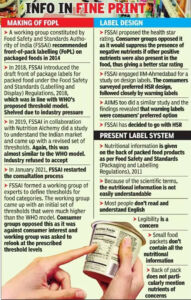When was the last time you looked at what’s written on the pack?
What if a warning message were printed clearly in front of the pack, would that help in making healthier choices?
The burden of obesity and diet related non-communicable diseases (NCDs) like diabetes, hypertension, and heart disease are rapidly on the rise across the country. The recently released National Family Health Survey 5 report (2019-2021) by the Union health ministry showed obesity at the national level has increased from 21% to 24% among women and from 19% to 23% among men. More than a third of women in Tamil Nadu, Kerala, Delhi, Andhra Pradesh and Punjab are overweight or obese.

It has been observed that one of the significant global responses to the NCD epidemic is the provision of nutritional information on food packs. However, it has become evident that such information, usually provided at the back of the pack, fails to adequately inform consumers. It is either difficult to notice and understand, or the information provided is confusing with no details about the presence of high salt, sugar and fats.
There are also other barriers like illiteracy and language. Thus, as part of national strategies to contain NCDs, several countries have introduced labelling on the front of pack. The main purpose of the front of pack labels is to warn consumers about the presence of increased quantities of negative nutrients like salt, sugar and fat, and nudge them towards healthier food choices.
Defining science-based limits for the nutrients of concern in various food products and having appropriate label design are the two important components of front of package labelling (FoPL). In 2018, FSSAI proposed a draft Food Safety and Standards (Labelling and Display) Regulations, 2018, highlighting certain criteria for labelling and display on the front of food packs. The FSSAI also laid down the thresholds for sugar, salt/sodium and fats for various foods and beverages, which were in line with the WHO-South-East Asia Regional Office science-based model. Faced by opposition from the industry, the FSSAI developed a modified set of thresholds in 2019 based on a study validated in accordance with the Indian context
A clear, interpretative warning label that will transcend the barriers of illiteracy and multiple languages in the country and would convey the message effectively is most suited for India. The best example would be the vegetarian and the non-vegetarian logo that is best understood by all.
Chile became the first country in the world to implement the FoPL law in 2016, after observing a steep increase in cases of obesity among adults and school children. Chile’s ministry of health started publishing annual assessments since then.
In 2018, the majority of consumers considered labels while buying and around 58. 4% chose foods with fewer warning labels.
Having invested much time and energy on introducing FoPL, it is crucial that FSSAI determine sciencebased thresholds for the presence of salt, sugar and fat in food categories and come up with an interpretative, label design that would benefit Indian consumers. It is also equally important that the authorities issue, mandatory regulations at the earliest, instead of the proposed voluntary one, so that FoPL could act as a crucial tool in containing NCDs in the country.


 WhatsApp us
WhatsApp us